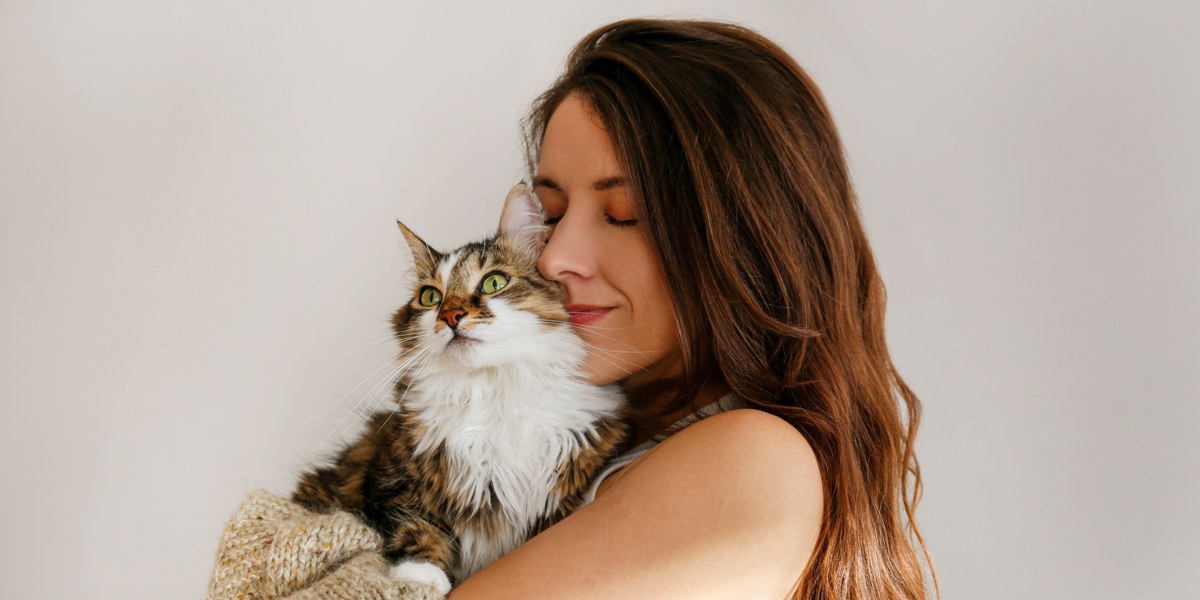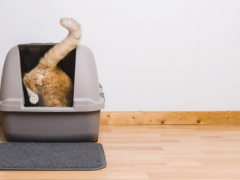
As cat owners, we all want our cats to like us, but they can be complicated creatures! Some cats are more independent and less outwardly affectionate than others, but it is possible to build a positive relationship and bond with any type of cat. Our pet cats have a unique set of requirements and behavioral traits that sets them apart from all other types of pets.
With an improved understanding of these, you’ll be well on your way to having a better relationship with your own cat. There are several main areas to focus on when trying to build a better relationship with your cat, whether you’re trying to encourage them to be more affectionate or solve a problem behavior.
Bringing Home a New Cat or Kitten
The first few days after bringing home your new friend are very important. They will probably be a little scared and timid until they settle in and learn that your house is their new home. At first, allow them access to just one or two rooms and make sure they can easily access their litter tray and food and water bowls.
Ensure your cat has plenty of hiding places as this will help them to feel safe and secure. Once they seem more settled, gradually allow them to explore the rest of the house.
Socialization
It is important to allow your new cat or kitten to explore your home at their own pace and come to you on their terms. Your cat needs to learn that they can trust you and this will probably take a bit of time and patience. Start by gently stroking your cat if they come to you and build up to picking them up gradually. Never force them to interact with you. Grabbing your cat for a cuddle before they’re ready will only frighten them and undo any trust that you have built so far.
Teach children to be calm and gentle around your cat and take time to introduce other family pets slowly. The most important thing to remember with all new introductions is to make sure your cat always has the opportunity to escape and hide if they want to.
Provide Adequate Nutrition
If you have a new cat or kitten, try and find out what food they have been fed prior to you adopting them and if possible, stick to feeding this during the initial few days. Make any changes to their diet slowly over about a week by gradually feeding more of the new food and less of the old food. This will help to prevent a tummy upset, or your cat refusing their new food.
Cats can sometimes be fussy so be prepared to offer a selection of foods until you learn which ones your cat likes best. That being said, try not to change their food too often as frequent diet changes could lead to an upset stomach. Some cats will prefer wet food, some will prefer dry, and some will enjoy a mixture of both! Speak to your veterinarian for more advice if you are unsure what to feed your cat.
Ensure Your Cat Stays Healthy

Register your cat with a veterinarian so that you always have someone to contact in an emergency or if your cat becomes unwell. You should also ensure that your cat is up to date with their routine vaccinations. Your veterinarian will also advise you on the best preventative flea and worm medication for your cat. This is especially important if they spend a lot of time outdoors.
The Importance of Resources
Cats can be fussy about their resources and things that may not seem like a big deal to you can have a big impact on your cat’s emotional welfare.
1. Food Bowls
Food bowls should be placed well away from your cat’s litter box and somewhere where your cat feels safe eating. For example, many cats will not want to eat next to a noisy washing machine or near a glass door where they could be observed by an outside cat. Some cats may prefer to eat up high on a shelf or work surface, but remember that older cats often suffer from arthritis and may struggle to jump up so will need their bowls on the ground.
2. Water Bowls
Cats often prefer to drink from a moving water source such as a dripping tap. Thankfully, rather than leaving your tap to drip, pet water fountains are available which can help encourage your cat to drink plenty of water. Cats also often prefer to drink from shallow dishes with a wide diameter, so try putting your cat’s water in a large shallow dog bowl.
Refresh the water frequently and again, make sure your cat’s water bowl is well away from their litter box.
3. Litter Box
Place your cat’s litter boxes in quiet locations where your cat will feel safe. The golden rule is to have one litter box per cat plus one extra. This means that if you have two cats, you should have a minimum of three litter trays in different locations. Cats are fastidiously hygienic, so clean out litter boxes daily otherwise they might refuse to use them.
4. Beds

Cats spend an average of 18 to 20 hours sleeping every day! So, their bed and its location are important! Your cat will probably choose where they sleep regardless of where you put their bed so you can always move their bed to this location. Your cat might prefer to sleep in different locations throughout the day so try and ensure they have different beds in various locations to give them a choice.
Cat Behavior
Understanding cat behavior and your cat’s body language is the key to having a better cat human relationship. You may have heard the expression “dogs have owners but cats have staff.” This gives the impression that cats are more aloof and do not show affection, but we as kitty parents know that this just isn’t the case! Cats show affection, but in very different ways to the way dogs do.
If you are new to owning a cat, you might not realize some of the ways in which your kitty is showing you they love you.
1. Slow Blinking
When your cat blinks slowly at you, it’s their way of telling you that they feel completely relaxed and safe in your company. You can try blinking slowly at your cat when he is relaxed and you might elicit a slow blink back in return! Never stare at your cat though, as this can have the opposite effect and is seen by your cat as a threatening gesture.
2. Head Butts
Many cats like to be stroked around their head and chin and will often gently “butt” you with their head to encourage you to pet them there. Try gently tickling under their chin, or scratching behind their ears, you’ll soon learn what your cat responds best to!
3. Tail Position
Your cat’s tail position can often tell you a lot about their mood. Cats will often hold their tail high when they are happy or pleased to see you. If your cat has their tail between their legs it can mean that they are anxious or frightened. If your cat’s tail is thrashing or whipping, this can often mean that they’re annoyed or agitated.
Get To Know Your Cat

All cats are individuals and have different personalities, likes, and dislikes, just like us humans do. Learn where they like to be petted as this may differ from cat to cat. Most cats prefer to be touched around their head and face and don’t enjoy their tummy or tail being stroked.
Even if your cat rolls onto their back and shows you their belly, this is rarely an invitation to stroke it, and beware, you might get swiped or nipped if you try! Purring is often a sign of a contented cat, but bear in mind that cats can also purr when they’re stressed or anxious.
Spend Quality Time With Your Cat
Although they may seem independent, cats can get lonely in the same way that we and other pets can. This may not necessarily mean that they will want to spend every moment sitting on your lap, but just knowing you’re in the house and a familiar routine can help. Cats are creatures of habit and do like having a routine. It’s a cat’s life after all!
1. Play
Most cats love to play as chasing and catching involve using their natural hunting instincts. Playtime can also be a great way for you to bond with your kitty. Keep play sessions short to just 10 minutes or so to ensure that you don’t exhaust your cat.
Laser pointer toys do not make good toys for cats. Although it might be entertaining to watch your cat chase the light, this is actually incredibly frustrating for your cat as they will not be able to understand why they cannot “catch” the light.
2. Grooming
Cats spend a lot of time grooming themselves and will usually keep their coats in tip-top condition, but many cats will still enjoy being groomed by you as well. As well as being a great way to bond with your cat, grooming them also helps to get rid of any dead fur and skin and prevent hairballs or matting.
3. Treats
Feeding your cat the occasional treat can help encourage them to trust you and bond with you. Don’t overdo it though as it’s important that your cat remains a healthy weight! Make sure any treats that you do give are suitable for cats and try to avoid giving human food to your cat unless you know that it is safe, such as small pieces of cooked chicken, or white fish.
Consider Cat Pheromones
When cats rub their heads or bodies on surfaces around your house, or against you, they are releasing pheromones which signal that they are relaxed and happy. Although they are undetectable to humans, cats are very sensitive to different pheromones and you can buy artificial pheromones in the form of plug-in diffusers which can help your cat to feel relaxed and safe in your home.
Conclusion

As you can see, there are many different ways in which you can strengthen the bond you have with your cat. Remember that all cats are different, just like we are, so get to know your cat’s likes and dislikes and the two of you will have a happy and harmonious life together for many years to come!
Frequently Asked Questions
How do you tell if you have a good relationship with your cat?
There are several things to look out for that can indicate you have a good relationship with your cat. If your cat seeks you out, sits on your lap, rubs their head against you, or slow blinks in your company, chances are you have a good relationship with your cat. Some cats are naturally more affectionate than others so do not worry if your cat doesn’t do any of these things, they might be showing their affection in other, less obvious ways!
Why is my cat not affectionate?
Remember that cats all have different personalities, just like humans do. Some cats are naturally more affectionate than others. Even if your cat doesn’t sit on your lap, or enjoy being stroked, he might be showing you more subtle signs of affection such as slow blinking, or rolling over and showing you his tummy.
How do I gain my cat’s trust?
The most important thing is to take things slowly and at your cat’s own pace. Never force an interaction and always allow your cat to escape and hide away if he wants to. You can encourage him to come to you by offering tasty treats and being calm and relaxed in his company.
How long do cats take to bond with you?
Cats are all different and some will bond with their human family more quickly than others will. It might take a few days or several months for your cat to learn to trust you, depending on his personality type and previous life experiences.








The estimated shipping for the hiking Navigator is so long!! I’ll have to wait more than a month before it arrives.. even with Amazon prime shipping. I wouldn’t recommend this to someone who is eager to use it on short-notice. Plan ahead to account for the slow arrival (because I’m sure it’s worth it)!
Good point, Vivian. Glad you shared that!